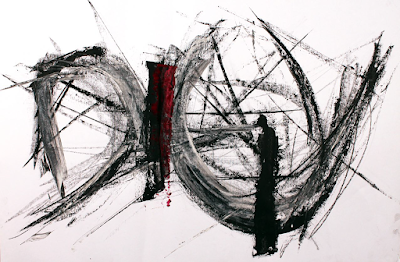Marko Kratohvil creates in two mediums of artistic expression - sculpture and drawing, but does not remain in the traditional framework of these disciplines, particularly regarding sculpture. His approach to sculpting as a process, to object as an entity of analysis and to materials as means of visual as well as revelatory expression, shows that Kratohvil inherits the artistic legacy of various revolutionary movements and ways of articulation in the history of sculpture. The fact that he is directly involved in the process of fabricating his large-format public projects, which are perceived as site-specific installations, or some sort of monument, suggests that he approaches the process of creating an artwork from the position of the Renaissance homo universalis or Constructivist artist-engineer. Having in mind that he uses steel, iron or mix of various industrial materials, the sort and the range of labor needed to be done (not just because of dimensions of the art piece, but also the complexity of the manufacturing process) requires a wide scope of knowledge in different fields. The artwork conceptualized and produced in this way brings back the notion and importance of the authenticity to contemporary sculpture, the forgotten concept which implies execution by the artist’s hand, his “fingerprint”.
It is interesting in this context, regardless of the media, to observe and compare Kratohvil's need for control over the process of production, perfectionism in the execution and restraint in expression, with his ideas about the spontaneity and the unpredictability of the creative process and the final outcome. This ambivalence reflects opposite tendencies in 20th-century art: balance of form, analysis, and abstraction, that both constructivist and modern sculpture tend to acquire in contrast to dadaist, surrealist, and abstract expressionist celebration of chance, accident, chaos, submission to the unconscious, and arbitrariness. The relationship between what artists consider the rational, objective, controlled approach to the process of creation and to its product, in Kratohvil’s work is intertwined with the approach usually perceived as subjective, impulsive, irrational and uncontrolled. His artistic language is the result of both, his thoughtful analysis of the outer world and deliberation as well as the reflection of the inner one. These ambivalent tendencies in his artworks don't imply a contradiction. They are rather an evidence of artist’s contemporaneity and an illustration of the need to “return to order” after the postmodernist “chaos” (pluralism). At the same time his works are carrying the experience of the whole century of experimenting, research and movement of boundaries in the possibilities of artistic expression.
Kratohvil’s drawings and sculptures share the aspiration to investigate the relationship between form and space. In both media he searches for balance in the dynamics of independent forms and the unity of all elements as a whole, which is characterized equally by structural order and respect for visual aspects. Lines in his drawings, in the same way as the forms in sculptures, always imply the motion, rhythm, and speed of the movement in space, conveying potential energy. This is expressed in their mutual relationship and within the individual elements as an illustration of the vigor of a single moment. The inexpressible and elusive specific moment, that sculptures and drawings tend to enhance, is exemplified, more in drawings and less in sculptures, by the traces of spontaneity in the execution. In spite of the visual similarities between drawings and sketches for sculptures, Kratohvil’s drawings should not be analyzed as sketches, nor should be compared to them. Drawings are independent visual artworks, that have none of the characteristics of sketches nor their function. By using the color in the manner of a painter, letting himself to experiment and yet almost always sticking to graphism of the drawing, the artist shows the capability to completely independently research his own artistic expression in a different medium. His sketches for sculptures/installations, in contrast to his drawings, always imply their function, both in the treatment of the line and in relation to space.
It is important to emphasize the context in which the artist works. The age of developed capitalism and the international market often requires from artist to make a compromise or sacrifice his own artistic statement and needs. In Kratohvil’s public sculptures and commissions, this compromise is reduced to adapting the form and relevance to the environment in which it is located - from the geographical position to the symbolic meaning that it aims to express. Nevertheless, in this adjustment, the artist is not quitting his style of visual expression; regarding form, material, composition and approach to the process of production, Kratohvil relies on his own artistic credo, freely and without much sacrifice.
Ana Simona
















Comments0
Post a Comment